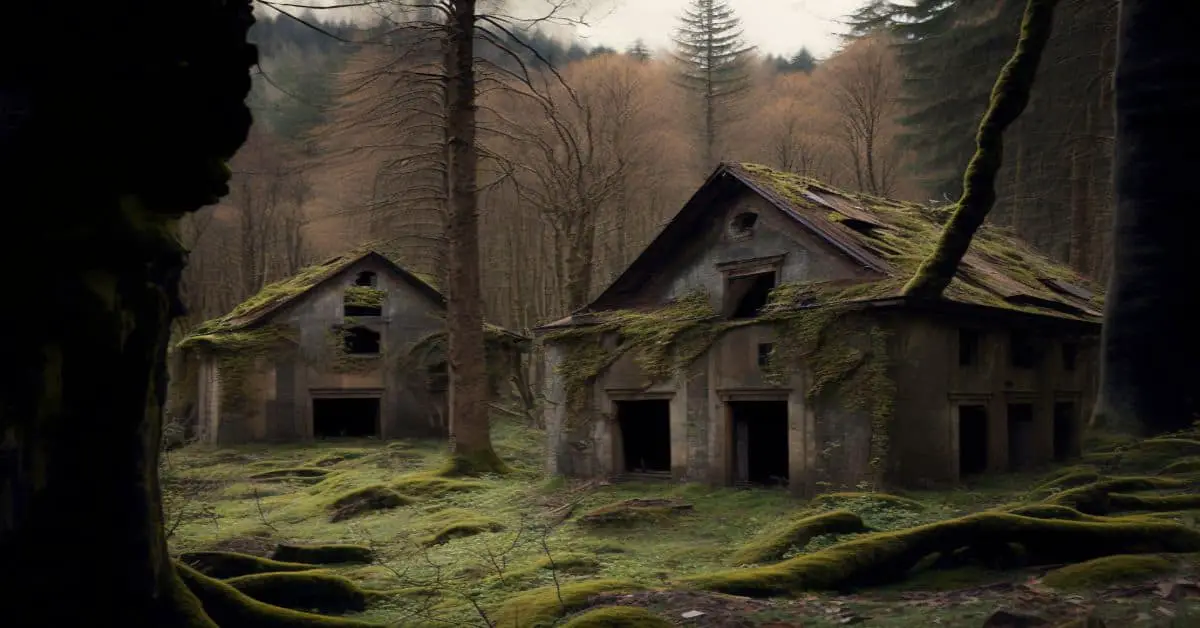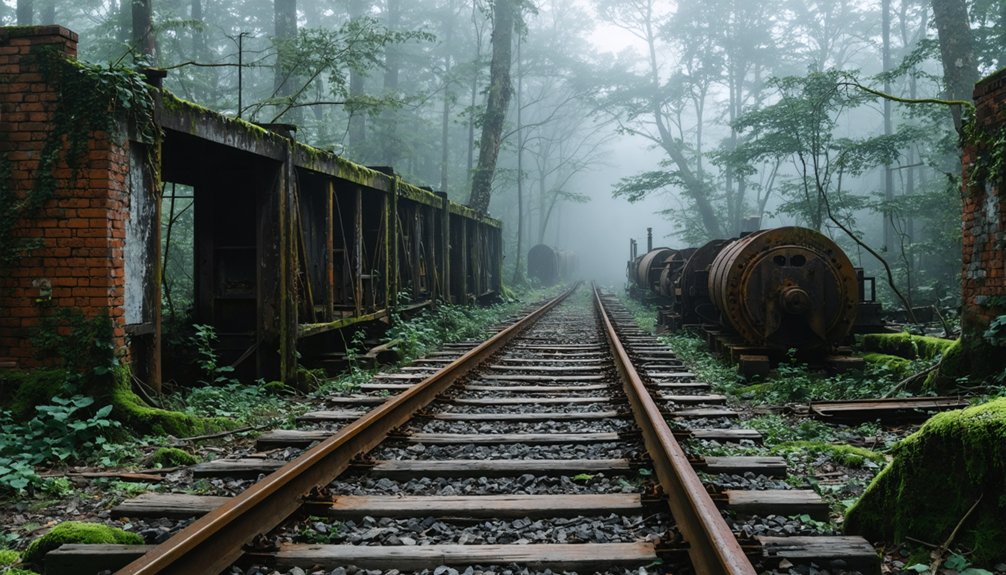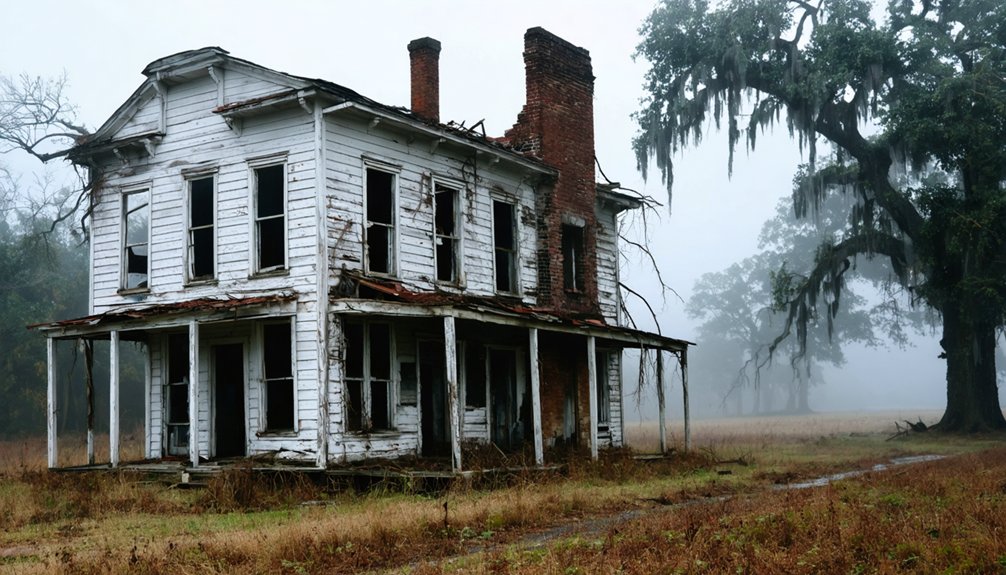You’ll find Mountain View’s ghost town remnants near Atlanta’s Hartsfield-Jackson Airport, where a vibrant community of 2,300 once thrived. Originally a stagecoach stop called Rough and Ready Tavern, the town grew around the first railroad station south of Atlanta. Despite its strategic location and clear views of Stone Mountain, airport expansion in the 1970s forced residents out through eminent domain. The town’s 1978 dissolution marked the end of an era, but traces of its rich history still whisper through abandoned structures.
Key Takeaways
- Mountain View was once a thriving railroad town near Atlanta with 2,300 residents before becoming completely abandoned by 1978.
- The expansion of Hartsfield-Jackson Airport forced residents to relocate through eminent domain and made the area uninhabitable due to noise.
- The town’s decline began with agricultural devastation from the boll weevil and worsened when the railroad bypassed the community.
- Mountain View’s city charter was officially revoked in 1978 following government dysfunction and inability to maintain basic municipal services.
- Only remnants remain today, with Mountain View Baptist Church being one of the best-preserved structures from the town’s history.
The Rise of a Small Georgia Community
While many Georgia communities emerged along transportation routes in the 19th century, Mountain View‘s origins can be traced to a humble stagecoach stop called the Rough and Ready Tavern.
The community growth accelerated when it became home to the first railroad station south of Atlanta, positioning itself 13 miles from East Point along the Macon and Western Railroad.
The town’s historical significance was further cemented when it earned its new name, Mountain View, due to its clear sightlines of Stone Mountain some 20 miles away. To prevent confusion with other locations sharing the name, the town maintained a disambiguation page on official records.
The town’s strategic location, dubbed the “Gateway to Clayton County,” established the town as an essential transportation hub, connecting Atlanta’s commerce to southern Georgia through both rail and stagecoach routes. At its peak, the thriving community supported a population of about 2,300 residents.
Life in Early Mountain View
Before European settlers established permanent roots in Mountain View, indigenous peoples, particularly the Mississippian and Cherokee cultures, shaped the region’s early character through their sophisticated agricultural practices and village structures.
The deer and beaver pelts became a vital part of the local economy after regular European trade was established in 1716.
You’d find native practices well-adapted to the local environment, with communities utilizing fertile river valleys for farming corn, beans, and squash. Early dwellings clustered in protected hollows, built from local timber and river cane.
Agricultural techniques blended both indigenous and settler knowledge, combining crop cultivation with livestock raising in the sheltered valleys. The Clovis culture was among the earliest inhabitants of the region, dating back nearly 13,000 years.
Life centered around strong community cohesion, with families working together through seasonal cycles of planting, harvesting, and hunting. The cultural landscape featured traditional crafts, storytelling, and folk customs that brought people together, creating a self-sufficient society until the Cherokee removal in the 1830s dramatically altered the region’s demographic makeup.
Transportation Hub and Railway Connections
The arrival of railway connections in Mountain View marked a dramatic shift from its earlier indigenous roots and agricultural beginnings.
You’ll find the town’s railway significance centered on its 1869 industrial spur, built by the Stone Mountain Granite Company to connect local quarries with the Georgia Railroad mainline. This crucial link integrated Mountain View into Georgia’s expansive rail network, with Atlanta serving as the primary hub connecting routes to Athens, Augusta, Macon, and Savannah. A historic abandoned tunnel from 1882 stands as a testament to the region’s rich railway heritage.
The town’s transportation legacy lives on through the remnants of its rail infrastructure. While the original tracks were removed, the Stone Mountain Memorial Association breathed new life into portions of the railroad in the 1960s, transforming the industrial spur into a tourist attraction that circles Stone Mountain. The railroad underwent major track upgrades in 2011 to maintain its role as a popular heritage railway destination.
Notable Landmarks and Buildings
You’ll find the former Town Hall‘s original foundation stones marking where Mountain View’s administrative center once stood at the intersection of Old Mountain View Road and Railway Avenue.
Like many Georgia ghost towns, Mountain View faced economic decline when the cotton boll weevil destroyed local agriculture.
The historic Railway Station‘s weathered platform and partial brick walls remain as evidence of the town’s importance as a transportation hub in the early 1900s. Similar to High Falls, the town’s fate was sealed when the railroad bypassed it, leading to its eventual abandonment.
The Mountain View Baptist Church, with its white clapboard exterior and bell tower still intact, stands as one of the best-preserved structures from the town’s heyday.
Former Town Hall Location
Located near the main thoroughfares of what was once Mountain View, Georgia‘s town hall served as an essential administrative center for approximately 2,300 residents until the city’s dissolution in 1978.
Similar to the city of Constitution’s incorporation in 1911 which sought to address local development concerns, the town hall location played a crucial role in managing the growing community’s needs.
Like many other local government buildings of the era that included militia registration, the building housed vital municipal functions, including the mayor’s office, city council chambers, and community meeting spaces.
You’ll find no trace of the original structure today, as airport expansion and urban development have completely transformed the area.
While the exact address remains unclear, historical records suggest it was situated near the historic Rough and Ready Tavern, a Civil War-era stagecoach stop.
The modest building likely followed typical mid-20th century Georgia town hall architecture, featuring brick or wood frame construction with dedicated spaces for administrative staff and public gatherings.
Historic Railway Station Remnants
Before Mountain View faded into history, its railway station stood as an essential transportation hub 13 miles south of Atlanta’s East Point terminus on the Macon and Western Railroad line.
The station evolved from the earlier Rough and Ready Tavern, a stagecoach stop also known as Bagley House, which served travelers on the Macon route.
Today, you won’t find any standing structures from the railroad era, though archaeological evidence might still exist beneath the surface.
Railroad artifacts, foundations, and iron hardware could potentially be uncovered through careful investigation.
During the Civil War, the station gained strategic importance as Lieutenant-General William J. Hardee’s temporary headquarters during the 1864 Atlanta Campaign.
While no photographs of the original wooden depot survive, its impact on Mountain View’s development remains documented in historical records.
Mountain View Baptist Church
Since its founding in 1921, Mountain View Baptist Church has served as a cornerstone of religious life and community outreach in the Baldwin area, roughly 13 miles south of Atlanta.
The church’s history began with 43 charter members who officially organized the congregation in 1947, establishing a foundation of faith-based service that continues today.
You’ll find this historic institution at 269 Mountain View Road, where it’s recently expanded its sanctuary to accommodate growing membership.
Throughout its century-long presence, the church has maintained its fundamental Baptist principles while adapting to serve evolving community needs.
Under Pastor Chad Parker’s leadership, the church emphasizes traditional worship styles and biblical teachings, offering regular events like “Watch the Lamb” productions and various community outreach programs.
Airport Expansion’s Impact
The expansion of Hartsfield-Jackson Atlanta International Airport led to widespread property buyouts in Mountain View, forcing residents to relocate as their homes were acquired through eminent domain processes.
You’ll find that increasing aircraft noise from the growing airport operations made the area increasingly uninhabitable for remaining residents throughout the 1970s and 1980s.
The combination of forced relocations and deteriorating living conditions ultimately transformed Mountain View from a vibrant community into an abandoned ghost town by the 1990s.
Property Buyouts and Relocations
During the mid-1980s, Mountain View’s landscape dramatically transformed as extensive property buyouts reshaped the community to accommodate Hartsfield-Jackson Airport’s expansion.
You’ll find evidence of these changes in the vacant lands north of Clayton MS and Northcutt ES, as well as the northeast corner of West Fayetteville Road and Norman Drive intersection.
The displacement consequences rippled through Mountain View and neighboring areas like College Park and Riverdale, severely impacting community cohesion.
While the Northwest Clayton Tax Allocation District now targets these vacant parcels for mixed-use development, federal law restricts airport-generated revenues solely to aviation purposes.
You’ll notice this limitation has complicated efforts to reinvest in the community, leaving many areas underdeveloped despite their potential for residential, commercial, and recreational use.
Noise and Residential Exodus
As Hartsfield-Jackson International Airport expanded its operations to nearly 2,500 daily flights, Mountain View residents faced an increasingly unbearable sonic assault that would ultimately erase their community.
The noise pollution was relentless, with jets roaring overhead every 45 seconds during peak times, creating one of the most severely impacted residential zones in the U.S.
Despite remarkable community resilience, you’d have witnessed Mountain View’s transformation from a thriving town of 2,000 to a ghost town through:
- Constant exposure to dangerous noise levels of 80-85 dBA
- Forced relocations and property seizures through eminent domain
- Rezoning from residential to commercial/industrial use
- Complete depopulation leading to the revocation of the city charter
The exodus marked a sobering example of how airport expansion can completely dissolve an established community.
The Slow Exodus of Residents
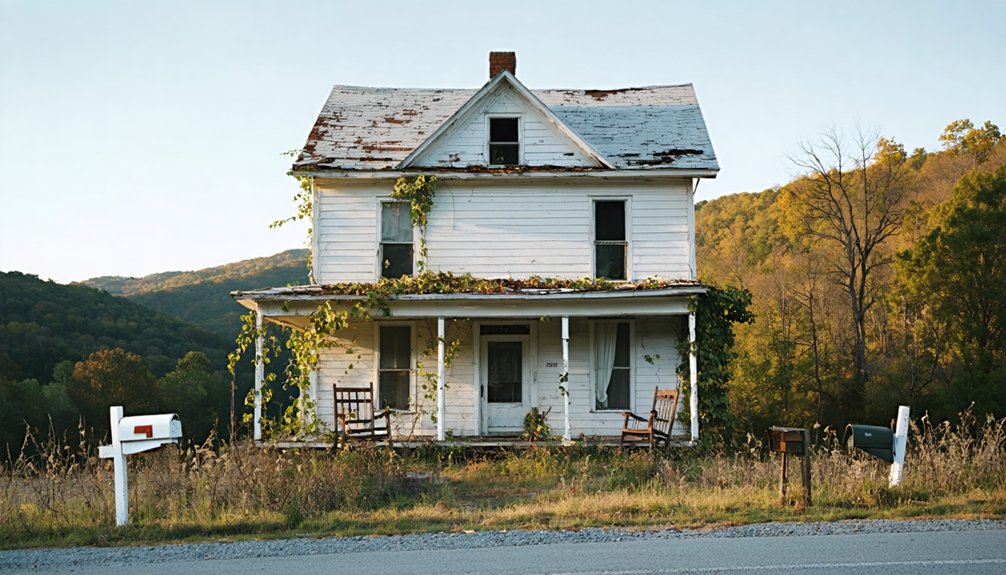
While Mountain View once thrived as a bustling community, its population began a steady decline in the late 20th century due to significant economic shifts.
Mountain View’s transformation from prosperity to decline reflected the harsh economic realities reshaping many American communities in the late 1900s.
You’d find residents moving away as local businesses and factories closed their doors, sparking widespread community migration toward Atlanta and other urban centers. The economic decline triggered a domino effect – as tax revenues fell, basic services deteriorated, making daily life increasingly challenging for those who remained.
You’ll understand how this wasn’t a sudden abandonment but rather a gradual process, as families weighed their options amid declining property values and diminishing opportunities.
The social fabric slowly unraveled as younger residents sought education and jobs elsewhere, leaving an aging population struggling with isolation and reduced community support in a town that was steadily fading away.
Final Days Before Disincorporation
Before Mountain View’s official dissolution in January 1978, the city faced mounting pressure from state officials over persistent violations of Georgia law and failed governance.
The signs of government dysfunction and community decline were unmistakable as the town spiraled toward its final days.
Four key factors sealed Mountain View’s fate:
- Blatant violations of Georgia’s Sunshine Law, with officials conducting business behind closed doors.
- Nightclubs operating beyond legal hours, highlighting the breakdown of local regulatory enforcement.
- Failure to maintain even three basic municipal services required by state law.
- Rampant speed traps on I-75 that became the city’s primary revenue source.
You’d hardly recognize the former community of 2,300 residents, as airport expansion and declining services transformed it into unincorporated Clayton County territory.
What Stands Today
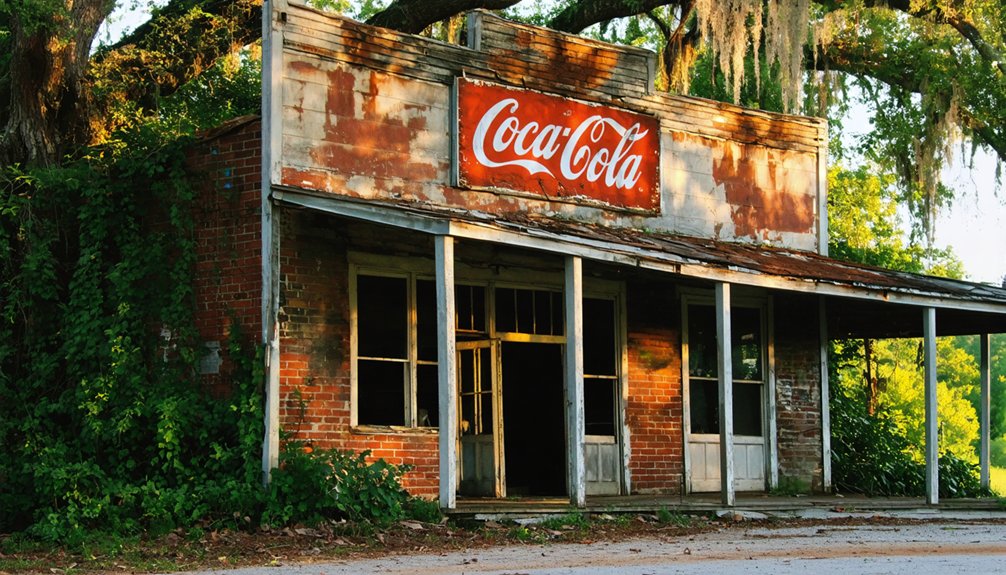
Today, little remains of Mountain View beyond scattered remnants of its urban infrastructure and deteriorating buildings.
You’ll find weathered structures dotting the landscape, from old houses to the shells of what were once general stores. Nature has steadily reclaimed much of the area, with vegetation overtaking abandoned structures and weathering taking its toll on the remaining architecture.
Despite its deteriorated state, the ghost town draws tourist interest from history enthusiasts and photographers seeking to document Georgia’s forgotten places.
While exploring these ruins, you’ll need to exercise caution due to structural instability. The decaying roads and bridges serve as silent witnesses to Mountain View’s past, offering glimpses into a once-thriving community that time has slowly erased from the modern landscape.
Legacy and Historical Lessons
Mountain View’s legacy extends far beyond its crumbling structures, offering valuable insights into Georgia’s rural development and economic evolution.
From abandoned buildings to economic lessons, Mountain View’s story captures the complex journey of Georgia’s rural transformation.
The town’s story serves as a poignant reminder of economic fragility in rural communities and the importance of preserving our rural heritage.
Here’s what Mountain View teaches us about Southern history:
- Small towns were vulnerable to broad economic shifts, from agricultural changes to transportation developments.
- Rural communities thrived on strong social bonds centered around shared institutions like schools and churches.
- The shift from bustling settlement to ghost town often happened gradually through outmigration.
- Physical remnants of ghost towns serve as vital historical markers, helping you understand Georgia’s economic and social transformation.
These lessons continue to resonate as rural communities face similar challenges today.
Frequently Asked Questions
Were There Any Notable Crimes or Mysteries Associated With Mountain View?
Like a town lost in the mist, you won’t find any documented unsolved disappearances or criminal activities here. Despite its ghostly status, historical records show Mountain View’s abandonment was purely economic.
What Happened to the Graves and Cemeteries When Mountain View Was Demolished?
You won’t find detailed records of grave relocation or cemetery preservation from Mountain View’s demolition. While standard practice suggests remains were likely moved elsewhere, there’s no concrete documentation of what happened.
Did Any Famous People or Celebrities Ever Live in Mountain View?
You won’t find documented celebrity sightings or famous historical residents in this community. Records show it was primarily a working-class area without any nationally recognized figures calling it home.
What Was the Peak Population of Mountain View During Its Prime Years?
Like finding a needle in a haystack, you won’t find exact peak population figures for this area. Despite historic landmarks and community events, no reliable population data exists for Mountain View’s prime years.
Were There Any Schools or Churches in Mountain View Before Disincorporation?
While you’ll find limited school history and church architecture records, you can’t definitively confirm specific institutions in the area due to scarce documentation about Mountain View’s community structures.
References
- https://roughdraftatlanta.com/2021/05/23/travels-with-charlie-georgias-ghost-towns-slideshow/
- https://dekalbhistory.org/blog-posts/the-forgotten-town-of-constitution-georgia/
- https://www.youtube.com/watch?v=kdE5O-cI1Bo
- https://www.visittownscounty.com/whispers-of-the-past-ghostly-tales-from-towns-county-georgia/
- https://flagpole.com/news/news-features/2013/10/23/exploring-georgias-ghost-towns/
- https://www.ezhomesearch.com/blog/ghost-towns-in-georgia/
- https://www.freakyfoottours.com/us/georgia/
- https://www.thedahloneganugget.com/news/tv-show-feature-local-ghost-towns
- https://en.wikipedia.org/wiki/List_of_ghost_towns_in_Georgia_(U.S._state)
- https://en.wikipedia.org/wiki/Mountain_View

